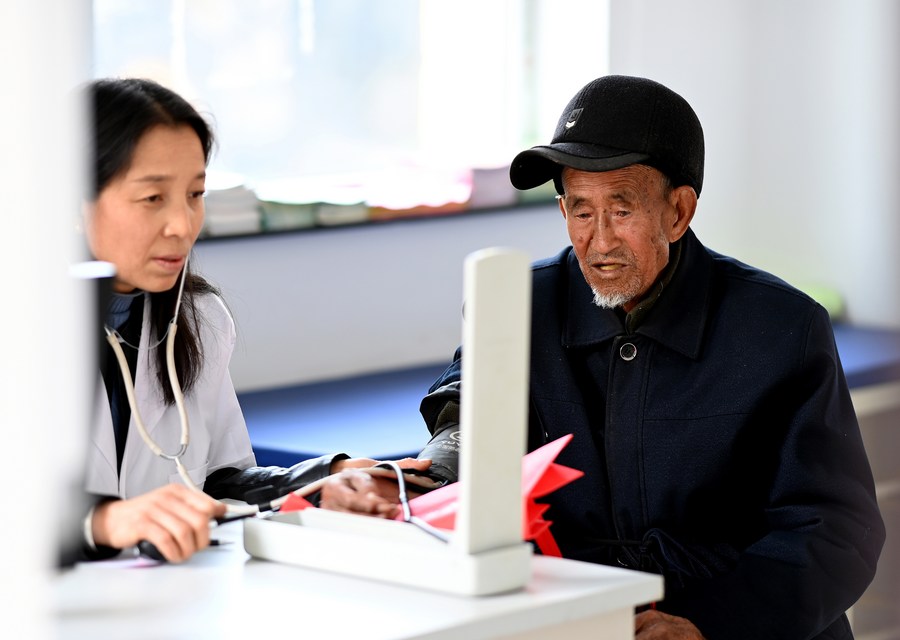China sees continued improvements in rural basic public services
China has seen continuously improving basic public services covering education, healthcare, housing, and social security in rural areas in recent years, constantly delivering a stronger sense of fulfillment, happiness, and security to rural residents.

Liu Qingji measures his blood pressure at a health service center of a residential compound for relocated villagers in Yukou Town of Fangshan County, north China's Shanxi Province, March 9, 2021. (Photo by Liu Liangliang/Xinhua)
Thanks to the country’s intensified support for education in rural areas, 99.8 percent of compulsory education providers have met the minimum requirements for running schools, and 96.8 percent of counties nationwide have realized balanced compulsory education. The number of students who dropped out of compulsory education across the country went from over 600,000 to 682, and more students from rural areas have entered colleges and universities.
China has directed more quality medical resources to grassroots health institutions and significantly improved rural medical conditions. By the end of 2020, 509,000 administrative villages had established 609,000 health centers with 1,442,000 medical staff members, and 567 counties had built 4,028 county-level medical communities.
Housing conditions in rural areas have also been improved. Since 2013, 7.9 million rural households, or a total of 25.68 million poor people, have moved out of dilapidated houses built of materials such as beaten earth and timber and moved into proper accommodation. From 2016 to 2020, all the 9.6 million poor rural residents who had been relocated from inhospitable areas had been moved into new homes.
During the same period, China upgraded a program to boost the safety of rural drinking water that benefited 270 million rural residents, of whom 17.1 million were people living below the poverty line. By the end of last year, the country’s centralized water supply covered 88 percent of the rural population and 83 percent of rural residents had access to tap water.
Since 2012, China has achieved steady improvement in social security in rural areas, such as refining its unified systems of basic medical insurance and serious disease insurance for rural and non-working urban residents, building a sound social assistance system covering both urban and rural populations, and improving its basic living allowances system.
As a result, the country’s basic medical insurance now covers 1.36 billion people, or above 95 percent of the population.
So far, 12.13 million people with disabilities facing financial difficulties have received living allowances, and 14.74 million people with serious disabilities received nursing care subsidies. Last year, 13.41 million temporary assistance grants were disbursed, up 46.1 percent year on year.
Starting from the end of 2017, all rural subsistence allowance standards at the county level have met or exceeded the national poverty line. As of 2020, 19.36 million registered poor people across the country had been given subsistence allowances.
China has also been ensuring a balanced allocation of public resources between urban and rural areas and promoted equitable rural access to basic public services since 2012, with more resources being channeled toward rural areas.
To push forward rural and agricultural development, expenditure on agriculture, forestry, and water conservancy from the central government’s general public budget increased from 1.2 trillion yuan in 2012 to 2.5 trillion yuan this year, with an average annual growth rate of 8.5 percent.
The Internet has given a big leg up to China’s efforts to improve equality in basic public services. Online education and telemedicine, for example, are introducing higher standard education and medical resources to rural areas. Over 1,100 internet-based hospitals in the country are bringing more convenient medical services for rural residents.
Furthermore, China has improved its care service system for children, women and seniors left behind in the rural areas. There have been 56,000 child welfare supervisors in towns and townships and 675,000 child welfare directors in villages, forming a strong grassroots force for children’s care and protection. China has also built more than 20,000 nursing homes and 108,000 mutual-assistance elderly care facilities in rural areas.
Photos
 Dance show saluting traditional culture of the Song Dynasty makes its debut
Dance show saluting traditional culture of the Song Dynasty makes its debut Village in SW China’s Yunnan embraces prosperity through agricultural tourism
Village in SW China’s Yunnan embraces prosperity through agricultural tourism Eighth birthday for pair of giant pandas celebrated in Haikou, Hainan province
Eighth birthday for pair of giant pandas celebrated in Haikou, Hainan province Olympic gold medalists portrayed in Shanxi artist’s polymer clay sculptures
Olympic gold medalists portrayed in Shanxi artist’s polymer clay sculptures
Related Stories
- China's public security departments keep improving cross-provincial services
- Public legal services reach urban, rural areas of China: Ministry
- 101-year-old ophthalmologist's undying passion for public service
- Xi stresses effectiveness of primary-level public services
- China plans strengthening public service at Nansha
Copyright © 2021 People's Daily Online. All Rights Reserved.






